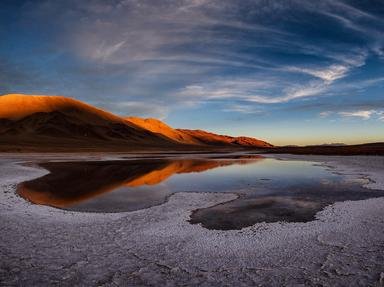Quiz Answer Key and Fun Facts
1. Argentina's capital city is Buenos Aires. Is it also the capital city of the province of the same name?
2. The largest and most populated province, Buenos Aires is mostly located within the Pampas region. However, a small section in the south could be considered to be part of what large desert?
3. Home to important touristic cities such as Villa Carlos Paz, La Falda, and Villa General Belgrano among others, this central province is also the site of the oldest university in the country. Sharing its name with a major city in Andalusia, Spain, which province are we talking about?
4. Another one of Argentina's most important provinces is Santa Fe. Most of the main urban centers are located along the shoreline of this river, which marks the eastern border. What important tributary to the Rio de la Plata flows along the east side of Santa Fe?
5. It might be far from this region, but the name of this province brings to mind what is considered the cradle of human civilization. What does Entre Rios mean?
6. The beautiful province of Corrientes has several geographical features to its account, and I definitely recommend visiting it. However, the province is also quite famous in another, non-geographical field. What widely collectible items were issued in Corrientes from 1856 to 1880, and are considered among the classics in that field? Definitely something to write home about!
7. We're heading for the Cuyo region, in the mid-western part of Argentina, to make our first contact with the Andes for this tour. The beautiful province of Mendoza will be our first stop. What landmark can be found in Mendoza, making the province especially attractive for adventurers?
8. The western province of San Juan is nicknamed "Land of the Sun". One of its main attractions is the Ischigualasto Provincial Park, a desert landscape with very curious geological formations. It is also known by what other name, referring to another "everyday" celestial object?
9. Villa de Merlo is a thriving touristic destination that attracts a growing number of visitors each year. Considered the city with best environmental quality in the whole country, it's located at the northeastern tip of which central province, that might remind some of the "Gateway to the West"?
10. The next region we'll be visiting is the Northwest. The first stop will be the city of Santiago del Estero, capital of the province of the same name, which is also the first city founded by the Spanish in the territory. It has the nickname of "Madre de Ciudades" (Mother of Cities). How did it earned that name?
11. La Rioja is another one of many Argentinian provinces to lay against the Andes mountain chain. One of its main cities appears to have been named after a neighbouring country. What is it called?
12. When traveling around the northwest of Argentina, the province of Catamarca is often overlooked. While it doesn't contain any of the most publicized touristic sites, you can treat yourself to a unique sight close to Antofagasta de la Sierra, in the northwest of the province. What extremely light volcanic rock forms this landscape?
13. Despite being the smallest province, Tucuman was a strategic location during the colonial times, and also a big and important economic center. Which of the following crops are its main commercial productions? They sure make for a refreshing drink during the hot summers.
14. Though it's not part of the main wine-making region, the town of Cafayate is known for producing some fine varieties that will make you "jump" for joy. The town is located in the Calchaqui Valley, in the southern part of which province? (there is a small clue in the question)
15. We've reached the northernmost province: Jujuy. One of its main regions is the Quebrada de Humahuaca, which became an UNESCO World Heritage Site in 2003. Among its many touristic attractions, you can find the "Pucara de Tilcara", a fortified citadel that was once part of which big aboriginal empire of the Andes region?
Source: Author
Gispepfu
This quiz was reviewed by FunTrivia editor
agony before going online.
Any errors found in FunTrivia content are routinely corrected through our feedback system.
